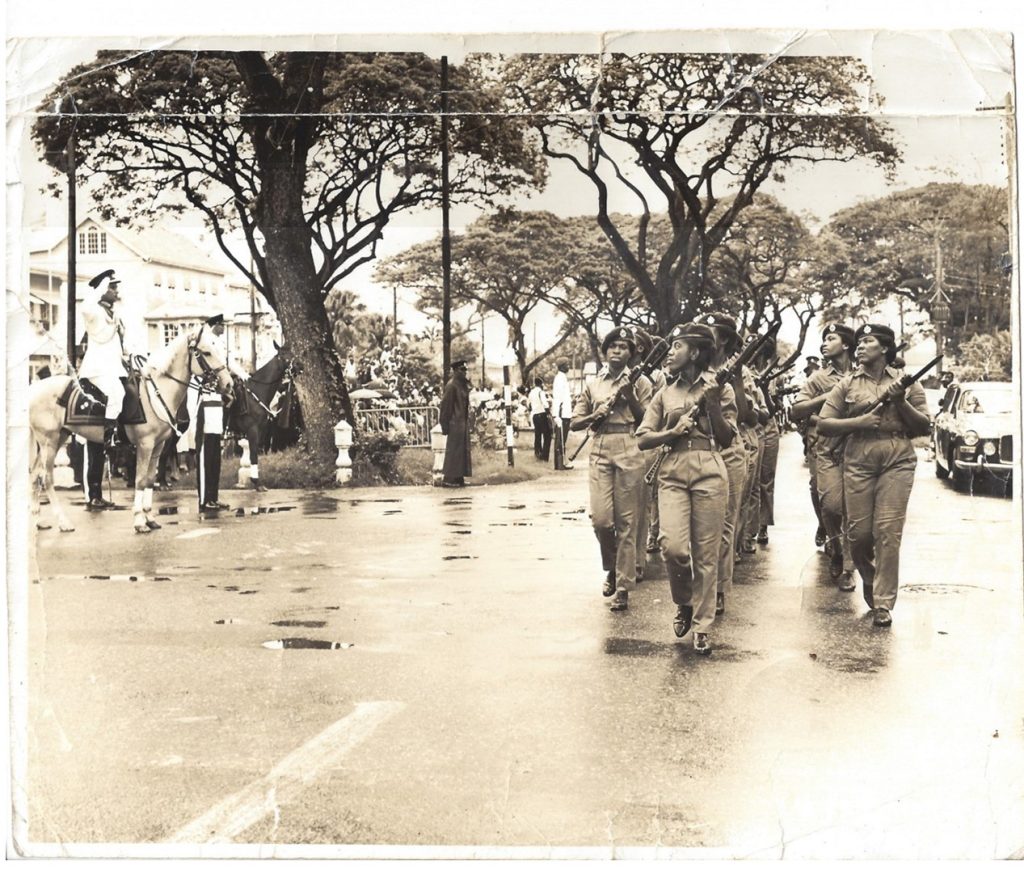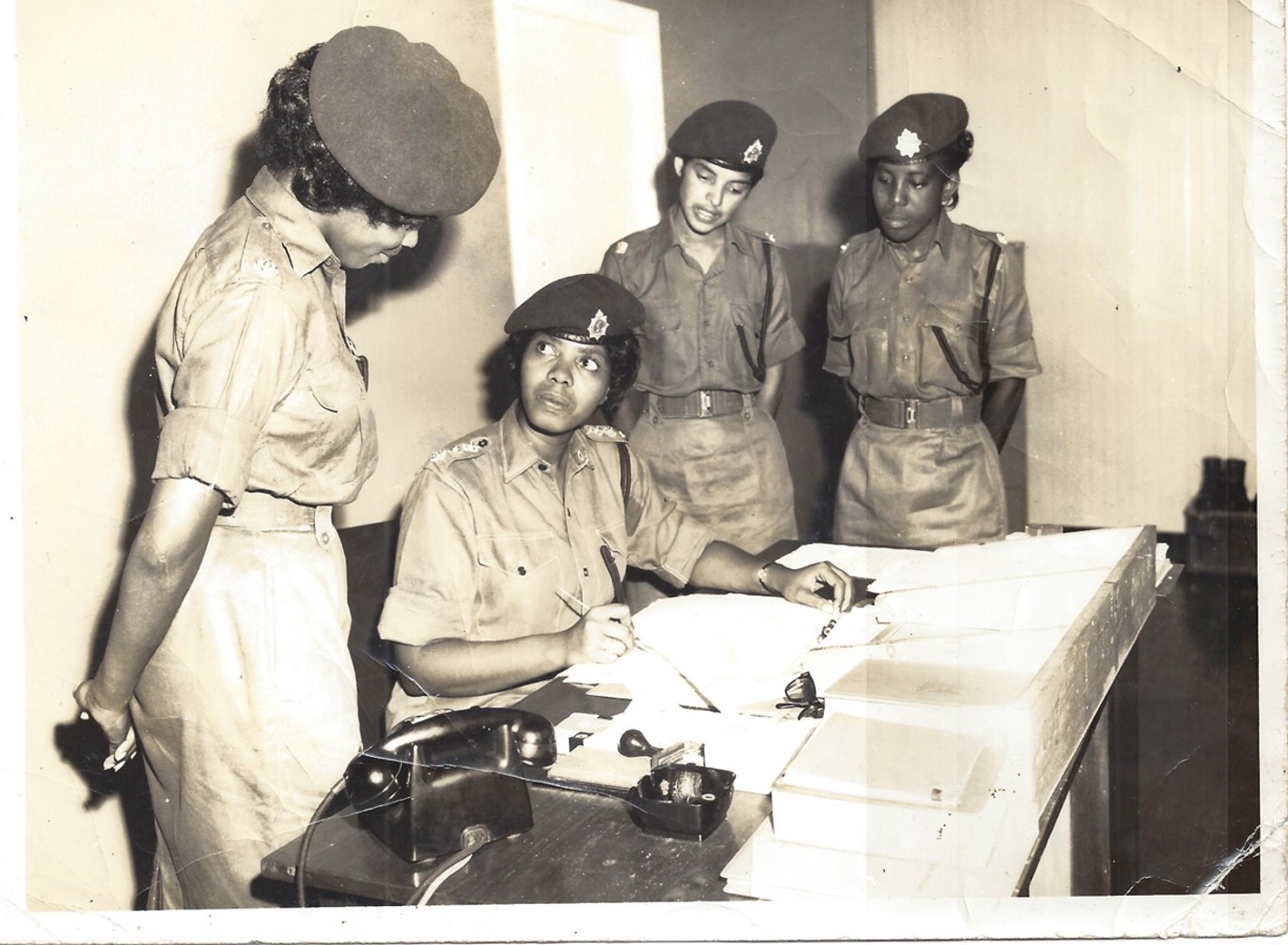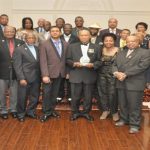The year was 1967, and as word spread that the newly formed Guyana Defence Force was looking to bring women on board, many of the country’s young womenfolk were eager to take advantage of the opportunity being afforded to them. Recruiting women was the way forward as the young Force was facing its first challenge; Venezuela had seized Ankoko in the Cuyuni River in October 1966 and troops had to be deployed to Eteringbang on the country’s westernmost frontier to confront its aggressors.
The result was a manpower problem and soldiers had to be found quickly to secure the borders and others had to take their place in the camps. The GDF’s solution was to recruit women.
The women were drafted into a military subculture which was characterized by male dominance and to which they seemed restricted to a particular role which encompassed clerical, medical and other non-combatant roles. This trend was evidenced until 1969, when the recruitment policy for women was changed and they were exposed for the first time to combat training.
The role of the Women’s Army Corps (WAC) was stated clearly as, “To provide a body of trained officers and women to be a ready reserve in any type of emergency, and to reinforce the regular element and replace men in non-combatant duties”

On the 30th January, 1967, the Guyana Defence Force recruited its first four female Officers; Joan Granger, Brenda Aaron, Hyacinth King and Clarissa Hookumchand. Granger (now deceased) was appointed the rank of Captain and with the anticipation of females joining, was immediately appointed the Officer of what was to be called the Women’s Army Corps. The others were made Cadet Officers and were subsequently elevated to the rank of Second Lieutenants.
“I was a teacher at the time and a friend of mine had read in the news that the GDF was going to begin recruiting women. I eventually saw the advertisement for myself and I said, ‘wow, this is the thing for me and I applied and I was called for several interviews. When I got in and I put on the uniform, things started happening. While as a child I liked marching, I hadn’t really given it much thought. Everything began to unfold and the greatest realization came when I went to Timehri. I fell in love with Timehri and there came also, my love for the Guyana Defence Force. After we were presented with our uniforms, we went to Timehri to commence our initial Officer training. Exactly one week later, we were followed by 56 other women who represented the Other Ranks, meant to be private soldiers. We did training under Major Neil Pullin, a British Army officer. Our training and the training for the Other Ranks were occurring simultaneously,” recollected Lt Col (ret’d) Brenda Aaron.
The Other Ranks received military training and were also trained to be specialists: cooks, signalers, telephone operators, typists and clerks.
After six weeks of training, the females were part of a passing out parade led by Major Neil Pullen. That first passing out parade for females was held at the then Atkinson Field, Drill Square, now Base Camp Stephenson.
After training, they were sent back to their jobs. King as a teacher, Hookumchand, an Income Tax Clerk and Granger, at then Radio Demerara. They were required to return one weekend per month for additional training, which lasted for over a year.
By 1969, the Corps of women was beginning to grow as yet another batch of women was recruited. The Corps of Women started as a small sub-unit and grew from strength to strength with the support of a great Corps of Men who knew and understood the reason for them being there. This batch underwent that strenuous training which the men normally endured. This included both jungle and conventional training at the Tacama Battle School. During their training, the women not only displayed great courage and skill but the standard attained was certainly high.
Women were being posted to all the units as specialists. They were an active Corps and conferences were held at least one weekend per month, which provided them with the opportunity to get together, organize, share experiences and lend support to each other.

In 1975, an exchange programme between the Guyana Defence Force and the British Military allowed for a batch of Officers and Soldiers to be sent to England for training. The women were attached to the Women’s Royal Army Corps (WRAC) in Aldershot, and used the opportunity to examine their system with a view to improving their Corps. They found that the WRAC did not commence any sort of weapon training for its females. But in 1975, the Guyana Defence Force Women’s Army Corps were already engaged in weapon training.
Of the 1000 applications received from females interested in enlisting as Other Ranks with the Guyana Defence Force, 200 were selected initially. However, in the final analysis, 60 were chosen. Many of them had just completed Commercial School, and were employed across the Public Service.
“A friend of mine told me that she heard that the military was recruiting women and she seemed very interested in it. She went as far to uplift the application forms for us and I didn’t worry to fill mine. However with her insistence, I decided to fill the form and I took it in the day, the very last day before the close off time for applications. Some time passed and I was called and I took the opportunity. To this day, I have no regrets of enlisting in the Guyana Defence Force. It remains the best working experience of my life,” says 3194 SSGT (Ret’d) Loraine Glasgow-Zephyr, a “first-day” female soldier.
In addition to her military training, Glasgow-Zephyr was trained by British Senior Non- Commissioned Officers as a Signaller and Switchboard Operator.
“I enjoyed every aspect of my military career. A high level of discipline was instilled in us by the Brits who trained us. The four female Officers who provided the right kind of leadership helped pave the way for us. The kind of discipline I benefited from the military has taken me throughout my life and if I could have done it again, I would still choose the Guyana Defence Force,” she noted.
Retired Staff Sergeant Glasgow-Zephyr later migrated to the United States of America where she went into the Field of Banking and Finance, and is currently the Vice President of the very active in the X-GDF Association, New York Chapter.
Of the four first Officers, Second Lieutenant Brenda Aaron was called to Regular Service and so was given the permanent responsibility of supervising the training of subsequent female batches.
As a Lieutenant, she commanded the Change of Guard parade at State House and, as a Captain, became the first female Officer to Command an all-female parade. She also commanded the first female Route March through the streets of Georgetown on the occasion of the country’s first Independence Anniversary. Aaron climbed the rank structure and retired as a Lieutenant Colonel, in 1994.
Joan Granger was relentless in her efforts in the defence and protection of female soldiers. She worked hard to have women Reservists accepted as Regulars and to have their conditions of service equated to those of men. She was embodied in the regular strength of the Force on December 1, 1976 and, by January 1, 1980, was promoted to the rank of Major. She retired in 1985, and passed on June 8, 2003.
Under a rigid selection process, another batch of female Officers was enlisted. At the time, the search was on for a Personal Assistant for the first Chief of Staff, Brigadier Clarence Price. Young Caroline Seaforth, was a public servant at the time and applied to take up the appointment following the completion of a series of processes. She was successful and was appointed on July 2, 1970. She served for 20 years in the Guyana Defence Force and held several appointments. She remembers a vibrant Women’s Army Corps that participated in almost every sport in the country. “My experience in the military gave me a better understanding of people, thus enabling me to see many things from a different perspective. It allowed me to be more focused, detailed and organized in my administration,” she stated. The female Officer Corps was growing.
Cheryl Pickering Moore, a young school teacher, joined the Corps as Personal Assistant to Commander Ulric Pilgrim and was Commissioned as a Second Lieutenant in January 1974. She was later elevated to the rank of Captain and successfully completed the Junior Staff Officer’s Course, which equipped her to function at the level of Middle Management. Apart from carrying out the duties as Personal Assistant to the Commander, Lieutenant Moore conducted interviews, assessments and training for new inductees in the Women’s Army Corps. The opportunity for pilot training presented itself and so Pickering, along with another female who subsequently enlisted, Beverley Drakes, went to the USA to be trained as pilots.
Pickering and Drakes received their training at the Embry Riddle Aeronautical University. In addition to being taught the Visual Flight Rules (VFR) she also completed a course in single and multi-engine aeroplanes and related academic areas in navigation, aerodynamics, aircraft systems, flight planning and aircraft performance. She participated further in an advanced course in ground school and pilot maintenance.
They both returned in 1977 becoming the first female pilots in Guyana. Drakes was immediately seconded to then Guyana Airways, while Pickering joined the GDF Force Air Corps, in 1977, where she flew the British Norman Islander Aircraft. She also served as Executive Officer, Air Corps for one year. In 1980 she was seconded to Guyana Airways, where she operated on domestic and overseas routes, but was still required to perform military duties from time to time.
“My path seemed to have been plotted. I loved my military career. I got an opportunity and I grabbed it with both hands. Being in the military prepared me. You just have to be disciplined and do what you have to and put your best foot forward,” she stated. Though she went on to a thriving career with Liat, where she rendered over two decades of dedicated service, Captain Cheryl Pickering said: “ In terms of my work life, I would say that being an Officer in the Guyana Defence Force will be at the top of my list.”
The experiences and contributions of the women who served in the earlier days of the Women’s Army Corps paved the way for the women who serve today.
Women of the Guyana Defence Force have performed exceptionally, proudly wearing their uniforms at every forum. The Corps has gracefully progressed over the years and has indeed come a long way. No one can doubt the value and significance of women in the GDF.
At the thanksgiving service to commemorate the 50th Anniversary of the Women’s Army Corps, First Lady Mrs Sandra Granger, in her address to the assemblage of female soldiers quoted late and former President L.F.S Burnham as saying, “ I recall that when we first recruited women into the Guyana Defence Force, the then Chief of Staff (Col Ronald Pope) thought that women should be allocated to secretarial duties and telephone operating. I gave an instruction then and I hope that that instruction has been carried out. Though perhaps women should get first choice on secretarial and telephone duties, they must understand that they are soldiers and the price …. which they pay for equality and being in the Guyana Defence Force must be their ability to do anything the men can do as well, if not better.”
Even as the former Commander in Chief then had envisioned for women in the military, today 53 years later, it has been evident that several have since risen to the challenge, taking on roles and appointments within the military that demonstrated their performance on the same level as their peers. The only anomaly that continues in the current configuration is that women have not yet been placed in combat positions within the Force. Despite this, women have been members of Jungle patrols at various times within the contemporary period of the GDF.
In 2012, Colonel Windee Algernon, broke the proverbial glass ceiling when she ascended to the rank of “full” Colonel, the first in any of the Anglophone Caribbean’s Armed Forces to hold such an appointment. Col Algernon, was a very dedicated Officer who devoted her life to the success and development of the Guyana Defence Force.
Yet another Officer, Colonel Ann Mc Lennan, who was seconded to serve in the Magistracy of Guyana since 2007, was promoted to the rank of Acting Colonel. She was recently appointed Chief Magistrate.
The achievements of women in the military not only serve to strengthen the resolve of women who serve the Guyana Defence Force, but also women across the Disciplined Services spectrum. The contemporary military environment, influences dedicated and committed women to reach their highest potential. An optimist, who is a former serving member, challenged the women folk to attain the rank of Brigadier. With plans afoot to foster their ability to conquer the frontiers of Guyana, the Military Woman in a few years, will know no boundary.
Editors Note: This article has also used information from Guyana Graphic, 29 October 1975 and National Defence – A brief history of the Guyana Defence Force 1965-2005 by David Granger








